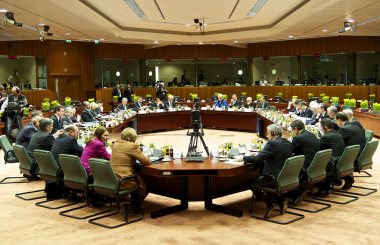European framework for nuclear waste
19 July 2011
Some European Union (EU) nations may have to speed up their radioactive waste management programs after a new policy directive was adopted in Brussels.
The directive officially adopted by the European Council today means every one of the EU's 27 member states must have, by 2015, a plan to safely dispose of radioactive waste using staff that are properly trained and regulated, as opposed to any other kind of method.
"With this directive, the EU becomes the most advanced region for the safe management of radioactive waste and spent fuel," claimed Energy Commissioner Günther Oettinger. The EU told its 500 million citizens that "the safety of spent fuel and radioactive waste management has cross-border implications and cannot be guaranteed under a strictly national approach."
 |
| The European Council is composed of the heads of government of every EU member state as well as its own president and the president of the European Commission |
The forthcoming national plans must cover transport of wastes and include a "concrete timetable for the construction of disposal facilities." They will be subject to scrutiny by the European Commission which could "require changes," although ultimate responsibility for waste management remains with member states. Plans are expected to use a step-by-step approach to geologic disposal based on the voluntary involvement of potential host communities.
Second time lucky
Today's nuclear waste directive represents part of a dramatically scaled back 'common EU approach' to nuclear safety announced as a package of directives in 2002.
The 2002 draft directive on waste gave "priority to geological burial of waste as the safest method known at present" and told EU states they must decide on a burial site "by 2008 at the latest and have the sites in operation at the latest by 2018."
This top-down decision making was rejected by most states, although Italy - holding the presidency of the EU in late 2003 - attempted to meet the targets, much to the anger of its citizens who felt consultation had been wholly inadequate when the first site was announced.
|
Two routes are acknowledged: one to dispose of used nuclear fuel as waste; the other to reprocess the fuel and recycle the uranium and plutonium while disposing of the remainder as waste. Exports of radioactive waste will be possible between EU states, which could combine to create a shared facility. Exports outside the EU will only be possible to countries that already have a repository in operation that meets IAEA standards. For overseas reprocessing, ultimate wastes must be returned to the originating EU country.
The directive made the use of International Atomic Energy Agency standards in waste management and disposal legally binding for EU states, and the directive's aims must be transposed into the national legislature of each EU member state within two years.
Some 143 reactors are deployed across 14 of the EU's 27 member states to provide over one third of total EU electricity. The other states still have responsibility to dispose of radioactive waste produced by research, medicine and industry.
Researched and written
by World Nuclear News